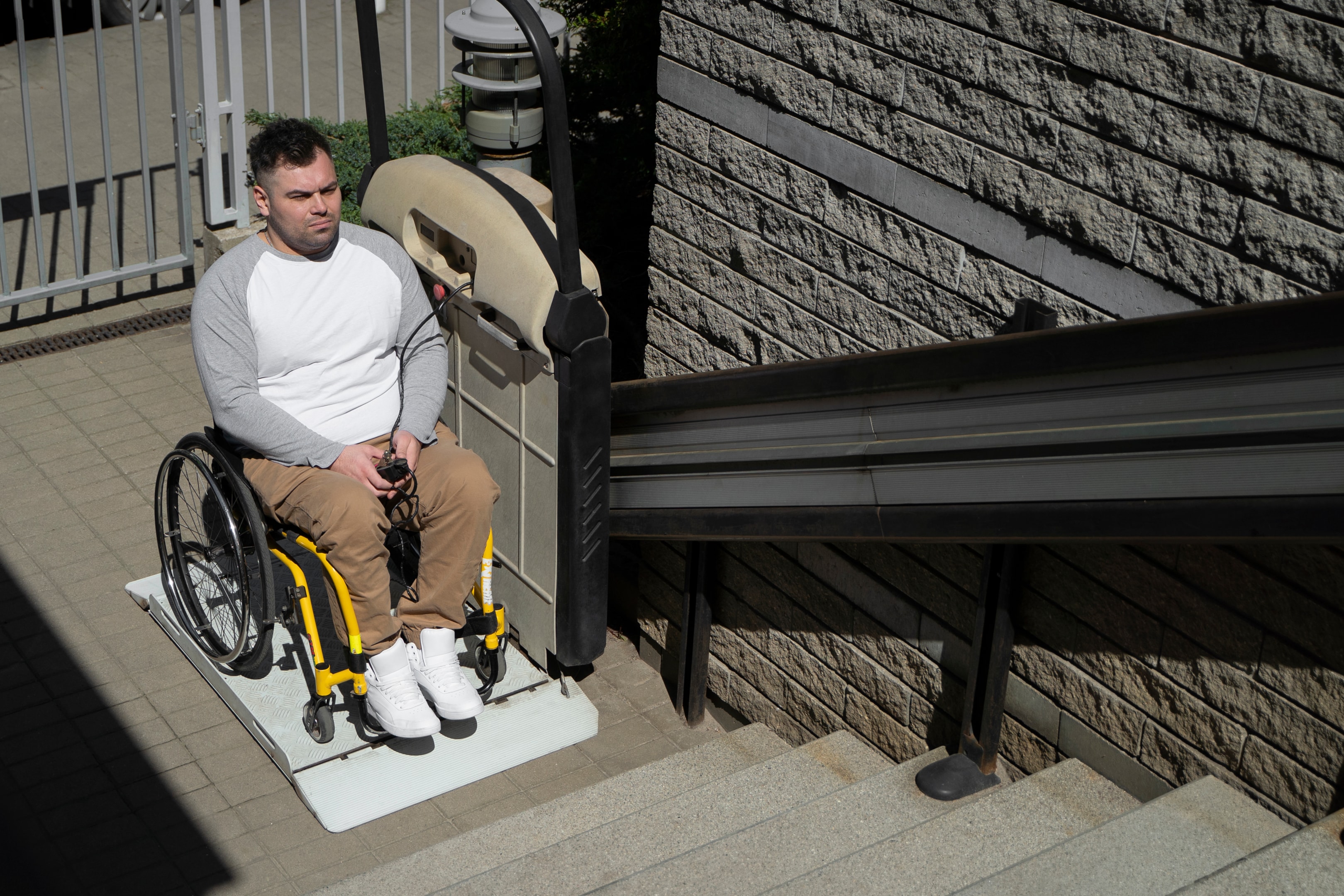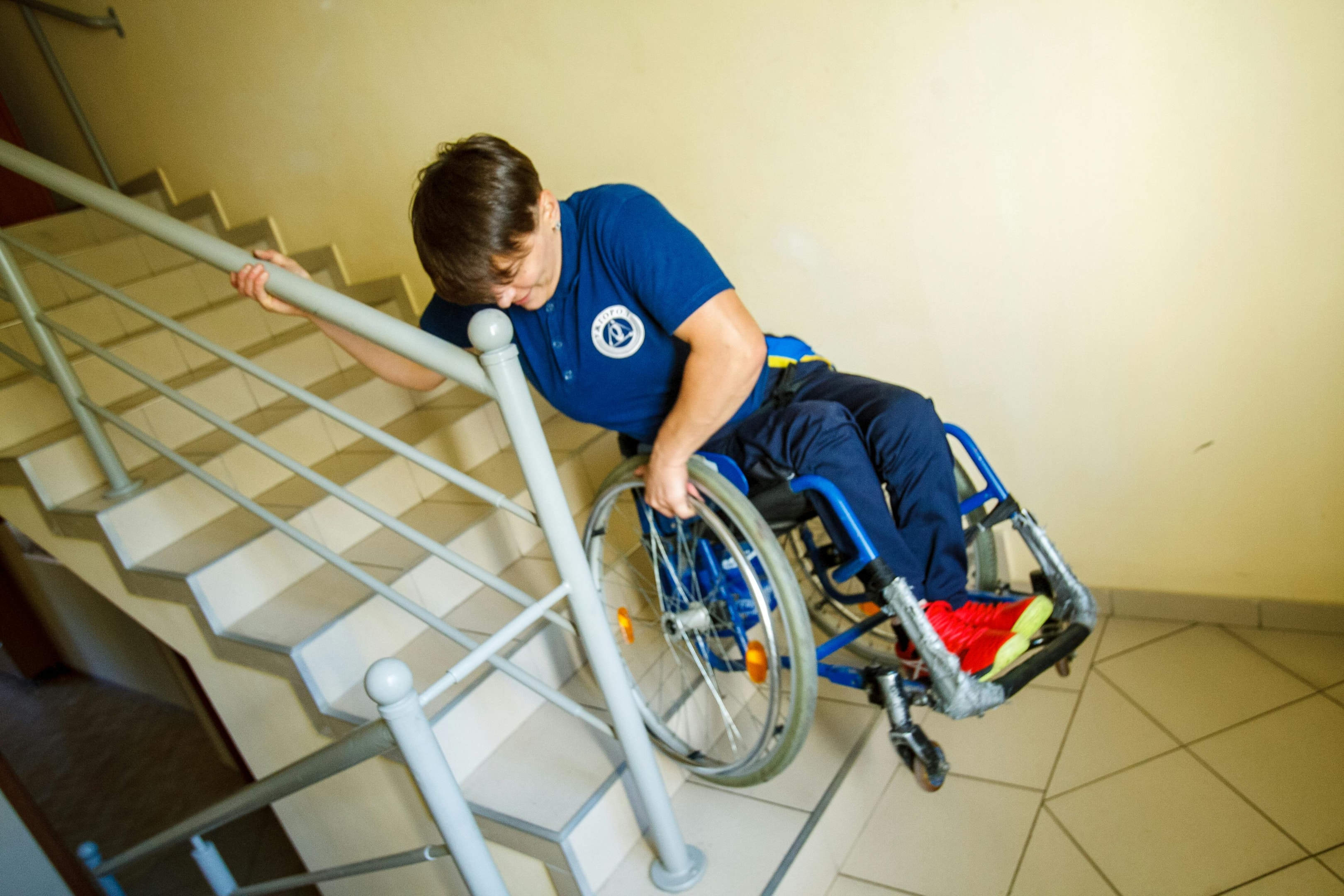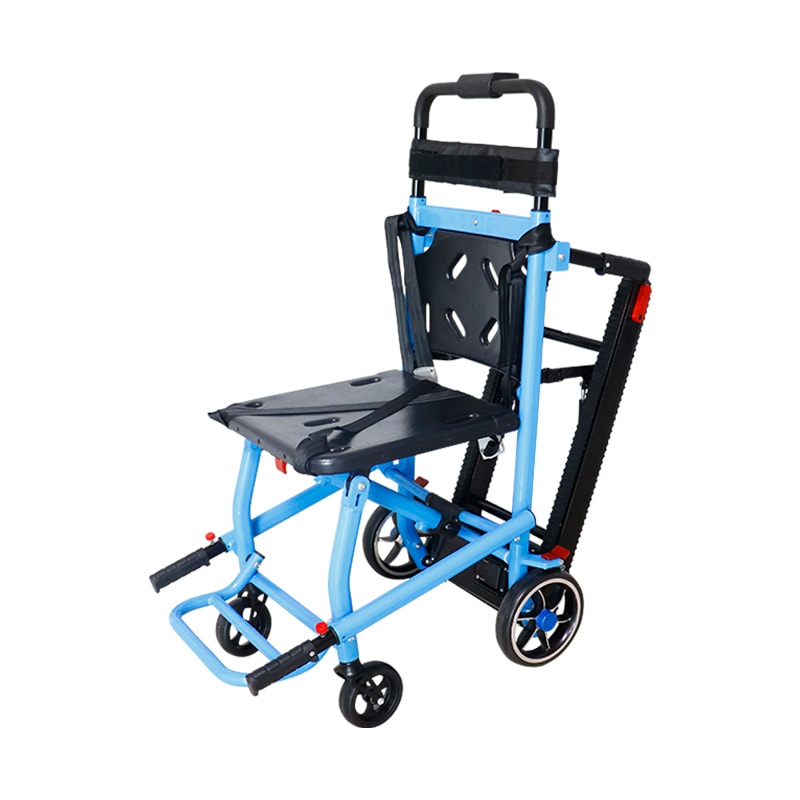Moving a patient up or down stairs isn’t easy, but stair stretchers are designed to make it safer and more manageable. They help navigate stairs and rough surfaces with less effort, ensuring both comfort and security.
From foldable designs to safety belts and easy maneuverability, the right stretcher can make all the difference. In this guide, we’ll explore the top options, key features to look for, and how to choose the best one for your needs.
Key Takeaways
- Stair stretchers are designed for safe patient transport over stairs and tough terrains, featuring foldable designs for easy handling.
- Key features include contoured foot ends for comfort, safety belts for security, and construction to enhance maneuverability in confined areas.
- Choosing the right model involves assessing quality, design, and budget; regular maintenance and inspection are crucial for optimal performance.
Understanding Stair Stretchers

Stair stretchers are explicitly crafted to convey patients over staircases and uneven terrain safely. They boast robust frames often equipped with systems that facilitate an easier lift and descent, thus maintaining safety throughout the patient’s transportation. The design focuses on safeguarding individuals by incorporating secure restraining straps and handles with anti-slip grips to bolster control and stability while moving.
Characteristically, these devices serve as funeral stretchers which are also compact in structure and capable of being folded. This makes them exceptionally well-suited for maneuvering within restricted areas. Their ergonomic configuration enhances rescuers’ mobility, allowing them to adeptly tackle difficult stairs and cramped areas where conventional stretchers may falter.
Designed to confront various challenges such as towering buildings, slender stairwells, or irregular terrains, stair stretchers stand ready to handle a multitude of transport scenarios efficiently.
Key Features of Stair Stretchers

Stair stretchers are equipped with various characteristics that render them essential in emergencies. They boast a design, contoured foot ends for stability, and secure safety belts which collectively contribute to the safe and effective movement of patients across stairs.
Design Construction
Employing an aluminum alloy for the construction of stair stretchers substantially diminishes their overall heft, thereby simplifying both management and transportation. In emergencies, this weight reduction is particularly vital as it enables rescue personnel to manipulate and carry the patient on a stretcher effortlessly.
This design improves agility when navigating confined areas, thereby increasing the effectiveness of rescue efforts.
Contoured Foot End
This stretcher has a contoured foot end crafted to enhance the comfort and safety of patients while being transported. It provides gentle support for the legs and feet, which helps minimize potential injuries or discomfort for the patient.
Its streamlined shape with a contoured design is especially beneficial when navigating through narrow passages and turning around corners. This component significantly improves patient protection as well as boosts efficiency during transportation.
Safety Belts and Straps
During the transport of patients, it is crucial to have stretchers that come with reliable straps and non-skid surfaces in order to guarantee their safety while being moved.
High-strength nylon is commonly used for these straps because it offers essential stability and can be adjusted easily, which helps maintain the security of the patient and avoid additional injuries.
Benefits of Using Stair Stretchers
Stair stretchers offer multiple advantages and are crafted to expedite the transport of patients, an aspect that is particularly vital in emergency scenarios. Such tools improve the efficacy of moving patients, even under difficult circumstances, rendering them essential instruments for rescue personnel.
To fully appreciate their utility, one can examine these benefits across various aspects where they contribute significantly.
Aid Manoeuvrability in Tight Spaces
Designed to navigate through confined areas with ease, stair stretchers boast a design optimized for maximum maneuverability in constrained areas like narrow hallways and stairwells. The contoured foot end of the stretcher is specifically shaped to avoid snagging on steps or obstructions, allowing for a more consistent and even stretch during transport.
Such characteristics make these stretchers essential tools for rescuers, ensuring they can efficiently move through narrow areas during emergencies.
Quick Evacuation in Emergencies
In the event of emergencies such as fires or earthquakes, stair stretchers are instrumental in enabling a swift evacuation by allowing for a secure descent from tall buildings. They serve as an essential tool for effectively moving patients to safety when elevators are not available.
The utilization of stair stretchers enhances the efficiency of patient removal during rescue operations, thereby conserving precious time that could be pivotal in life-threatening circumstances.
For further information on evacuation strategies and building safety standards, consult the NFPA’s Life Safety Code and Emergency Preparedness sections.
Reducing Physical Strain on Rescuers
Stair stretchers are crafted with an ergonomic design that enables rescuers to transport patients more effortlessly and navigate them smoothly, thereby lessening the physical strain involved in patient conveyance. The incorporation of characteristics such as ergonomic handles serves to diminish exertion, thus improving both efficiency and safety within rescue missions.
It is vital for the preservation of emergency workers’ health that this alleviation of stress be sustained, especially during extended periods of rescue activities.
Common Applications of Stair Stretchers

Stair stretchers serve as multi-functional tools, enabling rescuers to move effortlessly through different settings including towering structures and zones struck by calamities. These instruments increase the ease of maneuvering through restricted areas and ascending or descending stairs, a task that proves challenging when using conventional stretchers.
We should consider examining the widespread uses of these crucial pieces of equipment.
Complex Terrains
In treacherous environments like mountainous areas or wooded regions, stair stretchers play a crucial role in the secure conveyance of patients. The challenges posed by such landscapes are significant. The thoughtful design of these stretchers safeguards the well-being of both patients and those involved in rescue efforts.
Functioning as essential instruments during rescue missions, stair stretchers facilitate effective movement across rugged landscapes, demonstrating their critical value in emergency response scenarios.
Buildings Without Elevators
In buildings lacking elevators, stair stretchers serve as an essential tool for the challenging task of moving patients by conventional methods. Crafted to maneuver through building staircases, they facilitate secure and effective transport of patients in areas where space is restricted or when elevators are not an option.

Disaster Scenarios
In the event of emergencies such as fires or earthquakes, stair stretchers are pivotal for the safe evacuation of patients from buildings with multiple floors. These devices have been crafted with the purpose of securely transporting patients across stairs and irregular terrains, establishing them as vital tools during crisis situations.
The use of stair stretchers ensures a swift and secure exit strategy, aiding in preserving critical time for both emergency responders and those requiring assistance.
How to Choose the Right Stair Stretcher

Choosing the right stair stretcher involves considering several factors, including quality, design, and budget. Selecting a model that is easy to operate, durable, and within your budget is crucial.
Consider these factors to make an informed decision.
Assessing Quality and Durability
It is crucial to purchase a stair stretcher of superior quality and durability for dependable use in urgent situations. Opt for variants constructed with robust materials such as aluminum alloy or high-strength steel to achieve an ideal balance between endurance.
To prolong the service life of your stretcher, carry out regular checks and store it appropriately.
Evaluating Design and Features
When assessing stair stretchers, pay attention to crucial elements like their build, design with a contoured foot end, and the inclusion of safety belts. The incorporation of these elements improves both usability and efficiency in moving patients.
The thoughtful layout of a stretcher is pivotal in emergency scenarios as it plays an essential role in safeguarding the well-being and ease of patients as well as those conducting the rescue.
Considering Price and Budget
Stretchers for stairs come at various price points, enabling the selection of an option that aligns with your financial plan. Although it’s crucial to take account of the expense, you should not overlook key features critical for safe and efficient operation.
Striking a balance between cost, quality, and indispensable characteristics is instrumental in determining the most suitable stretcher for your requirements.
Maintenance and Storage Tips
To extend the durability and functionality of stair stretchers, it’s imperative to adhere to thorough upkeep and suitable storage practices. Diligent cleansing, consistent examinations for issues, and employing advocated methods for storing these devices are essential steps that help avoid deterioration and guarantee the stretcher is maintained in prime working order.
OSHA guidelines highlight the necessity of regular maintenance and inspection of stair stretchers to ensure optimal performance and safety.
Cleaning and Care
It is vital to keep a stair stretcher sanitary and operational by cleaning it regularly. Wipe the stretcher down with a wet cloth that has been soaked in mild detergent, steering clear of any strong chemicals that might deteriorate its condition.
To guarantee that stair stretchers are consistently reliable and safe for use, carrying out routine upkeep and thorough checks is imperative.
Proper Storage Solutions
Proper storage of your stair stretcher can greatly minimize the amount of area it takes up and protect it from harm. Opt for stretchers that include an uncomplicated, foldable design to facilitate straightforward transportation and storage.
Creating specific storage compartments, like shelving units, will assist in keeping an orderly arrangement of your stretcher within the store, ensuring it remains readily available.

Regular Inspections
It is essential to conduct frequent examinations to verify the operational integrity of all safety characteristics on the stair stretcher. These inspections should meticulously assess elements such as safety belts, overall structural soundness, and wheel performance to guarantee they are working seamlessly. Overlooking these routine checks may lead to malfunctions in equipment, thereby endangering both patients and those performing rescues.
Summary
In summary, stair stretchers are indispensable tools for safe and efficient patient removal in various challenging environments. From their lightweight construction to ergonomic designs and essential safety specifications, these robust devices are crafted to make a difference in emergency scenarios. Understanding their key features, benefits, price range and applications can help you choose the right model for your needs.
Contact Us
When it comes to patient transport, every second matters. At Jiekang, we provide high-quality stair stretchers engineered for smooth maneuverability, durability, and ease of use—ensuring safety and efficiency in any emergency.
With years of experience and a global customer base, we focus on delivering:
✅ Reliable & Sturdy Designs – Built for tough conditions
✅ Custom Branding Options – Match your facility’s standards
✅ Fast & Hassle-Free Delivery – Get what you need, when you need it
Join hospitals, emergency responders, and medical professionals worldwide who trust Jiekang for their patient transport solutions.
🔹 Explore Our Full Range here
🔹 Request a Free Quote
🔹 Talk to Our Experts Today
📞 Let’s discuss how Jiekang can support your facility’s needs. Contact us now!
Frequently Asked Questions
What materials are stair stretchers typically made of?
Stair stretchers are usually made of durable aluminum alloy to give them a robust layout.
It’s a solid choice for strength and ease of use!
Why are safety belts and straps important in stair stretchers?
Safety belts and straps on stair stretchers are super important because they keep patients secure and prevent any unwanted injuries during transport.
It’s all about ensuring everyone stays safe and stable, right?
How do stair stretchers aid in maneuvering tight spaces?
Stair stretchers help you maneuver confined areas because they’re lightweight and have a contoured foot end, which makes them easy to handle in narrow hallways and staircases.
They really come in handy when you’re dealing with tricky areas!
What are some key features to look for when choosing a stair stretcher?
When choosing a stair stretcher, focus on features like a lightweight model, a contoured foot end for comfort, and reliable safety belts and straps for security.
These will make transporting patients a lot easier and safer!
How often should stair stretchers be inspected?
You should inspect stair stretchers regularly to make sure all safety features are working and to avoid any issues while using them.
Keeping up with inspections is key to managing safety.



